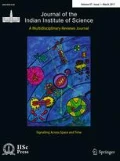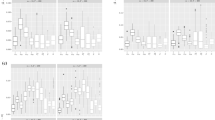Abstract
Discrete-time point-referenced spatio-temporal data are obtained by collecting observations at arbitrary but fixed spatial locations \(\varvec{s}_{1},\varvec{s}_{2},\ldots ,\varvec{s}_{n}\) at regular intervals of time \(t := 1,2,\ldots ,T\). They are encountered routinely in meteorological and environmental studies. Gaussian linear dynamic spatio-temporal models (LDSTMs) are the most widely used models for fitting and prediction with them. While Gaussian LDSTMs demonstrate good predictive performance at a wide range of scenarios, discrete-time point-referenced spatio-temporal data, often being the end product of complex interactions among environmental processes, are better modeled by nonlinear dynamic spatio-temporal models (NLDSTMs). Several such nonlinear models have been proposed in the context of precipitation, deposition, and sea-surface temperature modeling. Some of the above-mentioned models, although are fitted classically, dynamic spatio-temporal models with their complex dependence structure, are more naturally accommodated within the fully Bayesian framework. In this article, we review many such linear and nonlinear Bayesian models for discrete-time point-referenced spatio-temporal data. As we go along, we also review some nonparametric spatio-temporal models as well as some recently proposed Bayesian models for massive spatio-temporal data.
Similar content being viewed by others
Notes
Cressie and Wikle17 covered a wide range of materials on spatio-temporal modeling that serves as the main resource for many of the models that we cite subsequently.
References
Amini H, Taghavi-Shahri SM, Henderson SB, Hosseini V, Hassankhany H, Naderi M, Ahadi S, Schindler C, Künzli N, Yunesian M (2016) Annual and seasonal spatial models for nitrogen oxides in Tehran, Iran. Sci Rep 6(1):1–11
Banerjee S (2017) High-dimensional Bayesian geostatistics. Bayesian Anal 12(2):583
Banerjee S, Carlin B.P, Gelfand A.E (2003) Hierarchical modeling and analysis for spatial data. Chapman and Hall/CRC
Banerjee S, Gelfand AE, Finley AO, Sang H (2008) Gaussian predictive process models for large spatial data sets. J R Stat Soc Ser B (Statistical Methodology) 70(4):825–848
Berger J, De Oliveira V, Sansó B, Ren C, Wittig T (2003) Objective Bayesian analysis of spatially correlated data (vol 96, pg 1361, 2001). J Am Stat Assoc 98(463):779–779
Berger JO, De Oliveira V, Sansó B (2001) Objective Bayesian analysis of spatially correlated data. J Am Stat Assoc 96(456):1361–1374
Berliner LM (1996) Hierarchical Bayesian time series models. In: Maximum entropy and Bayesian methods. edited by Kenneth M. Hanson and Richard N. Silver, Springer:15–22
Berliner LM, Milliff RF, Wikle CK (2003) Bayesian hierarchical modeling of air-sea interaction. J Geophys Res Oceans 108(C4):1–18
Berliner LM, Wikle CK, Cressie N (2000) Long-lead prediction of pacific ssts via Bayesian dynamic modeling. J Clim 13(22):3953–3968
Bloomfield P, Oehlert G, Thompson ML, Zeger S (1983) A frequency domain analysis of trends in Dobson total ozone records. J Geophys Res Oceans 88(C13):8512–8522
Bruno F, Guttorp P, Sampson PD, Cocchi D (2009) A simple non-separable, non-stationary spatiotemporal model for ozone. Environ Ecol Stat 16(4):515–529
Bueno RS, Fonseca TC, Schmidt AM (2017) Accounting for covariate information in the scale component of spatio-temporal mixing models. Spatial Stat 22:196–218
Carroll R, Chen R, George E, Li T, Newton H, Schmiediche H, Wang N (1997) Ozone exposure and population density in Harris county, Texas. J Am Stat Assoc 92(438):392–404
Chakraborty A, Gelfand AE, Wilson AM, Latimer AM, Silander JA Jr (2010) Modeling large scale species abundance with latent spatial processes. Ann Appl Stat 4(3):1403–1429
Cox D.R, Isham V (1988) A simple spatial-temporal model of rainfall. Proc R Soc Lond A Math Phys Sci 415(1849):317–328
Cressie N, Huang HC (1999) Classes of nonseparable, spatio-temporal stationary covariance functions. J Am Stat Assoc 94(448):1330–1339
Cressie N, Wikle CK (2015) Statistics for spatio-temporal data. Wiley
Daniels MJ, Kass RE (1999) Nonconjugate Bayesian estimation of covariance matrices and its use in hierarchical models. J Am Stat Assoc 94(448):1254–1263
Das M, Bhattacharya S (2014) Nonstationary, nonparametric, nonseparable Bayesian spatio-temporal modeling using kernel convolution of order based dependent Dirichlet process. arXiv preprint arXiv:1405.4955
Datta A, Banerjee S, Finley AO, Hamm NA, Schaap M (2016) Nonseparable dynamic nearest neighbor gaussian process models for large spatio-temporal data with an application to particulate matter analysis. Ann Appl Stat 10(3):1286
Davis RA, Klüppelberg C, Steinkohl C (2013) Statistical inference for max-stable processes in space and time. J R Stat Soc Ser B (Statistical Methodology) 75(5):791–819
Deng JS, Wang K, Hong Y, Qi JG (2009) Spatio-temporal dynamics and evolution of land use change and landscape pattern in response to rapid urbanization. Landsc Urban Plan 92(3–4):187–198
Dimitrakopoulos R, Luo X (1997) Joint space-time modeling in the presence of trends. In: Geostatistics Wollongong’96 1: 138–149
Dou Y, Le ND, Zidek JV (2010) Modeling hourly ozone concentration fields. Ann Appl Stat 4(3):1183–1213
Fonseca TC, Steel MF (2011) Non-gaussian spatiotemporal modelling through scale mixing. Biometrika 98(4):761–774
Fuentes M (2002) Spectral methods for nonstationary spatial processes. Biometrika 89(1):197–210
Fuentes M, Chen L, Davis JM (2008) A class of nonseparable and nonstationary spatial temporal covariance functions. Environmetrics 19(5):487–507
Furrer R, Sain SR (2009) Spatial model fitting for large datasets with applications to climate and microarray problems. Stat Comput 19(2):113–128
Gamerman D, Lopes HF, Salazar E (2008) Spatial dynamic factor analysis. Bayesian Anal 3(4):759–792
Gelfand AE, Banerjee S (2017) Bayesian modeling and analysis of geostatistical data. Annu Rev Stat Appl 4:245–266
Gelfand AE, Banerjee S, Gamerman D (2005) Spatial process modelling for univariate and multivariate dynamic spatial data. Environmetrics 16(5):465–479
Gelfand A.E, Diggle P, Guttorp P, Fuentes M (2010) Handbook of spatial statistics. CRC Press
Gelfand AE, Ecker MD, Knight JR, Sirmans C (2004) The dynamics of location in home price. J Real Estate Finance Econ 29(2):149–166
Giannitrapani M, Bowman A, Scott M, Smith R (2006) Sulphur dioxide in Europe: statistical relationships between emissions and measured concentrations. Atmos Environ 40(14):2524–2532
Gneiting T (2002) Nonseparable, stationary covariance functions for space-time data. J Am Stat Assoc 97(458):590–600
Guha S, Bhattacharya S (2014) Gaussian random functional dynamic spatio-temporal modeling of discrete time spatial time series data. arXiv preprint arXiv:1405.6531
Guttorp P, Meiring W, Sampson PD (1994) A space-time analysis of ground-level ozone data. Environmetrics 5(3):241–254
Haas TC (1990) Lognormal and moving window methods of estimating acid deposition. J Am Stat Assoc 85(412):950–963
Heaton MJ, Datta A, Finley AO, Furrer R, Guinness J, Guhaniyogi R, Gerber F, Gramacy RB, Hammerling D, Katzfuss M et al (2019) A case study competition among methods for analyzing large spatial data. J Agric Biol Environ Stat 24(3):398–425
Higdon D (1998) A process-convolution approach to modelling temperatures in the north Atlantic ocean. Environ Ecol Stat 5(2):173–190
Holland DM, De OV, Cox LH, Smith RL (2000) Estimation of regional trends in sulfur dioxide over the eastern united states. Environmetrics 11(4):373–393
Hooten MB, Wikle CK (2007) Shifts in the spatio-temporal growth dynamics of shortleaf pine. Environ Ecol Stat 14(3):207–227
Huerta G, Sansó B, Stroud JR (2004) A spatiotemporal model for Mexico city ozone levels. J Roy Stat Soc Ser C (Appl Stat) 53(2):231–248
Hughes JP, Guttorp P (1994) A class of stochastic models for relating synoptic atmospheric patterns to regional hydrologic phenomena. Water Resour Res 30(5):1535–1546
Huser R, Davison AC (2014) Space-time modelling of extreme events. J R Stat Soc Ser B Stat Methodol 76(2):439–461
Jun M, Knutti R, Nychka DW (2008) Spatial analysis to quantify numerical model bias and dependence: How many climate models are there? J Am Stat Assoc 103(483):934–947
Jurek M, Katzfuss M (2021) Multi-resolution filters for massive spatio-temporal data. J Comput Graph Statist 30(4):1–16
Katzfuss M, Cressie N (2012) Bayesian hierarchical spatio-temporal smoothing for very large datasets. Environmetrics 23(1):94–107
Knight JR, Dombrow J, Sirmans C (1995) A varying parameters approach to constructing house price indexes. Real Estate Econ 23(2):187–205
Kyriakidis PC, Journel AG (1999) Geostatistical space-time models: a review. Math Geol 31(6):651–684
Lemos RT, Sansó B (2009) A spatio-temporal model for mean, anomaly, and trend fields of north Atlantic sea surface temperature. J Am Stat Assoc 104(485):5–18
Lu Z, Steinskog DJ, Tjøstheim D, Yao Q (2009) Adaptively varying-coefficient spatiotemporal models. J R Stat Soc Ser B (statistical methodology) 71(4):859–880
McDermott PL, Wikle CK (2017) An ensemble quadratic echo state network for non-linear spatio-temporal forecasting. Stat 6(1):315–330
McDermott PL, Wikle CK (2019) Bayesian recurrent neural network models for forecasting and quantifying uncertainty in spatial-temporal data. Entropy 21(2):184
McDermott PL, Wikle CK (2019) Deep echo state networks with uncertainty quantification for spatio-temporal forecasting. Environmetrics 30(3):e2553
Milliff R.F, Bonazzi A, Wikle C.K, Pinardi N, Berliner L.M (2011) Ocean ensemble forecasting. part i: ensemble Mediterranean winds from a Bayesian hierarchical model. Q J R Meteorol Soc 137(657):858–878
Paciorek CJ, Yanosky JD, Puett RC, Laden F, Suh HH (2009) Practical large-scale spatio-temporal modeling of particulate matter concentrations. Ann Appl Stat 3(1):370–397
Paez MS, Gamerman D, Landim FM, Salazar E (2008) Spatially varying dynamic coefficient models. J Stat Plan Inference 138(4):1038–1058
Reinsel G, Tiao GC, Wang M, Lewis R, Nychka D (1981) Statistical analysis of stratospheric ozone data for the detection of trends. Atmos Environ (1967) 15(9):1569–1577
Sahu SK, Gelfand AE, Holland DM (2010) Fusing point and areal level space-time data with application to wet deposition. J Roy Stat Soc Ser C (Appl Stat) 59(1):77–103
Sahu SK, Mardia KV (2005) A Bayesian kriged Kalman model for short-term forecasting of air pollution levels. J Roy Stat Soc Ser C (Appl Stat) 54(1):223–244
Sain SR, Furrer R, Cressie N (2011) A spatial analysis of multivariate output from regional climate models. Ann Appl Stat 5(1):150–175
Sampson PD, Guttorp P (1992) Nonparametric estimation of nonstationary spatial covariance structure. J Am Stat Assoc 87(417):108–119
Sang H, Jun M, Huang JZ (2011) Covariance approximation for large multivariate spatial data sets with an application to multiple climate model errors. Ann Appl Stat 5(4):2519–2548
Sans Ó B, Schmidt A.M, Nobre A.A (2008) Bayesian spatio-temporal models based on discrete convolutions. Can J Stat 36(2):239–258
Sanso B, Guenni L (1999) Venezuelan rainfall data analysed by using a Bayesian space-time model. J R Stat Soc Ser C (Appl Stat) 48(3):345–362
Schmidt AM, Gonçalves KC, Velozo PL (2017) Spatiotemporal models for skewed processes. Environmetrics 28(6):e2411
Smith RL, Tebaldi C, Nychka D, Mearns LO (2009) Bayesian modeling of uncertainty in ensembles of climate models. J Am Stat Assoc 104(485):97–116
Stein ML (2005) Space-time covariance functions. J Am Stat Assoc 100(469):310–321
Stroud JR, Müller P, Sansó B (2001) Dynamic models for spatiotemporal data. J R Stat Soc Ser B (Statistical Methodology) 63(4):673–689
Tebaldi C, Sansó B (2009) Joint projections of temperature and precipitation change from multiple climate models: a hierarchical Bayesian approach. J R Stat Soc A Stat Soc 172(1):83–106
Tonellato SF (2001) A multivariate time series model for the analysis and prediction of carbon monoxide atmospheric concentrations. J R Stat Soc Ser C (Appl Stat) 50(2):187–200
Tonellato SF et al (2005) Identifiability conditions for spatio-temporal Bayesian dynamic linear models. Metron-Int J Stat 63(1):81–101
Turkman KF, Turkman MA, Pereira J (2010) Asymptotic models and inference for extremes of spatio-temporal data. Extremes 13(4):375–397
Waller LA (2005) Bayesian thinking in spatial statistics. Handb Stat 25:589–622
Wikle CK (2019) Comparison of deep neural networks and deep hierarchical models for spatio-temporal data. J Agric Biol Environ Stat 24(2):175–203
Wikle CK, Berliner LM, Cressie N (1998) Hierarchical Bayesian space-time models. Environ Ecol Stat 5(2):117–154
Wikle CK, Holan SH (2011) Polynomial nonlinear spatio-temporal integro-difference equation models. J Time Ser Anal 32(4):339–350
Wikle CK, Hooten MB (2010) A general science-based framework for dynamical spatio-temporal models. TEST 19(3):417–451
Xu K, Wikle CK, Fox NI (2005) A kernel-based spatio-temporal dynamical model for nowcasting weather radar reflectivities. J Am Stat Assoc 100(472):1133–1144
Zammit-Mangion A, Wikle CK (2020) Deep integro-difference equation models for spatio-temporal forecasting. Spatial Stat 37:100408
Acknowledgements
We would like to thank an anonymous referee whose suggestions lead to an improvement of the review article.
Author information
Authors and Affiliations
Corresponding author
Ethics declarations
Conflict of Interest
The authors declare that they have no conflict of interest.
Additional information
Publisher's Note
Springer Nature remains neutral with regard to jurisdictional claims in published maps and institutional affiliations.
Rights and permissions
About this article
Cite this article
Guha, S., Bhattacharya, S. Bayesian Modeling of Discrete-Time Point-Referenced Spatio-Temporal Data. J Indian Inst Sci 102, 1189–1204 (2022). https://doi.org/10.1007/s41745-022-00298-w
Received:
Accepted:
Published:
Issue Date:
DOI: https://doi.org/10.1007/s41745-022-00298-w




